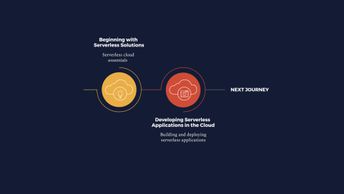Final Exam: Beginning with Serverless Solutions - compare multi-cloud architecture patterns for building portable applications
- compare the prominent AWS Lambdaâsupported languages from the perspective of cold start performance, warm performance, cost, and ecosystem
- configure and set up a simple Python HTTP GET endpoint on GCP Cloud Functions
- configure Kubernetes environment for multi-cloud application portability
- convert an existing Node and Express-based application to a Serverless-friendly application in the cloud
- create a simple REST API with Python running on AWS Lambda and API Gateway using the traditional Serverless Framework
- define portability and list challenges and elements to be considered when designing and developing a portable software
- define the concept of FaaS and recall programming models that help developers in selecting serverless architecture and runtime
- deploy an HTTP Node.js Azure Function and demonstrate how to read properties and set a result back to Azure
- describe technology evolution and benefits of the serverless mindset
- describe the approach of using an open-source serverless framework for developing and deploying serverless computing solutions across cloud service providers
- describe the elements and categories of cloud computing portability and interoperability
- describe the features of Azure Functions and outline how to select the right programming language to implement Azure Functions Runtime
- describe the features of different serverless systems and how they help facilitate computing, storage, and queue processing
- describe the OpenAPI specification and features of prominent tools that work with OpenAPI
- describe the purpose of different serverless pattern categories
- differentiate between the characteristics of serverless computing and Platform as a Service (PaaS)
- distinguish between the features and use cases of serverless and container deployment
- distinguish between the features of service-oriented and serverless architecture and identify the business benefits of the latter
- identify application design principles for designing interoperable software applications that can be integrated with other products
- identify the differences between containerized and serverless implementation and describe the considerations for their selection as an appropriate strategy
- identify the features and advantages of serverless architecture
- install and configure node dependencies to build and deploy REST APIs using Serverless, Express, and Node.js on AWS
- list common architectures that integrate serverless approaches and identify factors to consider when implementing a serverless architecture
- list the major serverless providers and the popular serverless frameworks that enable developers to explore the aspects of serverless computing
- outline characteristics, benefits, and applications of serverless architecture
- outline considerations for selecting a serverless implementation
- outline the changing dimensions of application operation and usability offered by serverless application architectures
- outline the development lifecycle and role of specification in maximizing portability
- recall benefits, challenges, and use cases of multi-cloud
- recall prominent serverless development and deployment technologies and map them to serverless solutions
- recall the concept of containerization and components of a typical containerization platform that provides portability
- recall the journey of cloud computing from the shared mainframes era to managed cloud solutions
- recall the languages that can be used to develop serverless applications for diversified serverless providers
- recognize differences between DevOps and NoOps and describe the impact of NoOps on serverless deployment
- recognize how serverless architectures change development processes and impact businesses
- recognize key principles and classes of strategies that help achieve greater portability in software and service units
- recognize prominent serverless computing platforms and the advantages of runtime
- recognize the types of Cloud Functions provided by GCP to implement serverless applications along with the language runtimes supported by GCP to write Cloud Functions
- use Node.js to set up a simple HTTP GET endpoint on GCP
|


